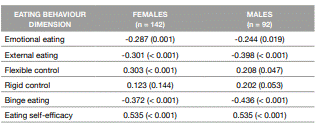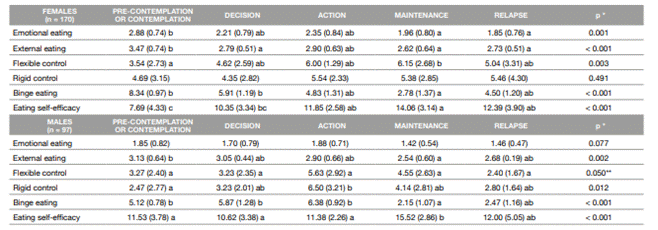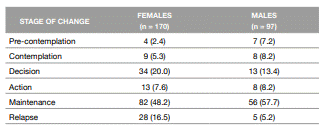INTRODUCTION
Eating behaviour is a multidimensional construct that refers to quantitative and qualitative features of the selection and decision on the foods to be consumed (1). Emotional eating refers to the tendency to eat as an inadequate response to negative emotions and stress, and external eating corresponds to a tendency to increase consumption in response to external stimuli related to food, namely seeing or smelling food. By the opposite, dietary restraint involves conscious attempts to reduce food intake in order to control body weight (2). Binge eating refers to episodes of consumption of large amounts of food in a brief period, accompanied with a feeling of lack of control (3, 4). Although not formally a dimension of eating behaviour, eating self-efficacy is a key construct to be assessed simultaneously, since some of the findings for these dimensions may be related to the perception of efficacy regarding food intake (5, 6).
Locus Control (LoC) represents a generalised expectation about the degree of control exercised by the individual on the events or reinforcements that occur in his/her life (7). This concept was applied to health for the first time by Walston (1992) (8). The internal LoC (i-LoC) corresponds to the belief that personal results are related to personality, capacity, and will power, while the external LoC (e-LoC) means that these results are attributed to “other powerful” (e.g. health outcomes due to doctors' actions) or randomly assigned by chance (9). Despite some authors report that in some situations of acute or chronic illness it might be more advantageous to believe in the power of others, overall, i-LoC is associated with better health outcomes (10). Studies that evaluate the relationship between LoC and eating behaviour dimensions are scarce. Micali et al. (2017) (11), in a longitudinal study among middle-aged women, found e-LoC to be a risk factor for developing binge eating disorder.
The Transtheoretical Model attempts to explain and predict how and when individuals change behaviour. This model is based on the notion of stages of change (SoC), which describes a series of five stages towards a specific behavioural transformation (12): a) pre-contemplation, in which there is no intention to change behaviour; b) contemplation, in which the person is aware that the problem exists and thinks about the change, but is not yet committed to it; c) preparation, in which there is the intention to act in the near future; d) action, with behaviour modification already verified; and e) maintenance (or termination), focused on relapse prevention and earnings consolidation. The SoC model presents a dynamic evolution and a spiral design, as relapses are common and individuals can go up and down stages several times before term (13, 14). Most studies that use the Transtheoretical Model to study food and eating focus on the consumption of fat, fruits and vegetables, dietary strategies for weight control and diabetes (15) and its usefulness when treating eating disorders (14, 16). However, no studies were found evaluating the relationship between SoC and eating behaviour dimensions. Thus, the aim of this work was to study the relationships between several dimensions of eating behaviour with the health LoC and SoC towards healthy eating among Portuguese higher education students.
METHODOLOGY
This study was approved by the ethics committee of Centro Hospitalar de São João, E.P.E. (Porto, Portugal). It was conducted on a convenience sample of Portuguese higher education students aged 18 to 27 years old. Written informed consent was obtained from students willing to participate. All questionnaires were self-administered in a written format, in the presence of a member of the research team. Data collection took place between between February and July 2012.
Socio-demographic and anthropometric data were collected with a questionnaire where participants reported their sex, age, education, height and current weight (without shoes or clothing). Emotional and external eating were measured using the Dutch Eating Behavior Questionnaire (DEBQ) (17). In the Portuguese version of DEBQ, both the emotional eating (13 items) and the external eating scales (10 items) showed good internal consistency (Cronbach’s alpha of 0.94 and 0.81, respectively). The flexible and rigid control of eating behaviour was measured with the subscales proposed by Westenhoefer, Stunkard, and Pudel (1999) (18). The Portuguese version of these subscales (19) comprise 11 and 14 items respectively and have revealed acceptable internal consistency in samples of the general population and higher education students (Cronbach’s alphas between 0.75 and 0.82). The Portuguese version of the Binge Eating Scale (BES), composed of 16 items, was used to assess binge eating severity (20). Since when the study began the BES was not yet adapted for the European Portuguese, slight linguistic adjustments were made from the Brazilian Portuguese version. Both versions have presented good internal consistency (Cronbach’s alpha of 0.87 and 0.89, respectively for the Brazilian Portuguese (21) and European Portuguese (22) versions). Eating self-efficacy was measured using the General Eating Self-Efficacy Scale (5). This 5-item scale has shown to be a valid and reliable instrument to measure general features of eating self-efficacy (Cronbach’s alpha values above 0.85). Higher scores on each eating behaviour scale correspond to higher level of the dimension it measures.
The Health Locus of Control Scale (9) is the only scale measuring health LoC currently validated for the Portuguese population. It is composed by 14 items, divided into two factors: “locus of control” (8 items) and “other powerful” (6 items). Some items were recoded so that a higher score in each item corresponded to i-Loc. The SoC towards healthy eating were assessed using the question and items from Kearney et al. (1999) (23), adapted to refer specifically to the adoption of healthy eating.
Statistical analysis was conducted using IBM SPSS version 22.0 for Windows. Spearman’s correlation coefficients (rs) were calculated to measure the association of eating behaviour dimensions with LoC and SoC (used excluding “relapse” and as an ordinal variable). Oneway ANOVA was used to compare eating behaviour between SoC (due to small group sizes, Pre-contemplation and Contemplation were combined and SoC were used as a nominal variable to include relapse). When significant differences were found, pairs of stages were compared using Student’s t-test with Bonferroni’s correction. The null hypothesis was rejected when p < 0.05.
RESULTS
From 394 students invited, 32 refused to participate and 95 provided incomplete data. So, we analysed data from 267 participants from which 170 (63.7%) were females and 97 (36.3%) were males.
Table 1 presents the correlations of BMI and eating behaviour dimensions with health LoC. No significant associations were found between BMI and health LoC. In the female subsample, and although these correlations are all very weak, i-LoC assessed through the factor “locus of control” was negatively associated with binge eating and positively with eating self-efficacy. However, we also found a negative association between eating self-efficacy and i-LoC assessed by the factor “other powerful”. Among men, none of the eating behaviour dimensions presented an association with health LoC.
The distribution of both subsamples per SoC is shown in Table 2. More than half of the males and almost half of the females were classified in the stage of maintenance. The correlations between stages of change towards heathy eating and eating behaviour dimension were similar for both sexes (Table 3). Earlier stages of change (Pre-contemplation and Contemplation) were associated with higher emotional, external and binge eating, and with lower levels of flexible control (no significant associations were found with rigid control). Earlier stages were also associated with lower eating self-efficacy, being these the strongest correlations.
Table 4 presents and compares eating behaviour dimensions between stages of change towards healthy eating. Most dimensions (all except rigid control in females and emotional eating in males) presented significant differences between stages. Among females, the highest levels of emotional, external and binge eating were found for those in pre-contemplation or contemplation stages. Women in the decision stage didn’t differ from those (pre-contemplation or contemplation) regarding binge eating. Flexible control was highest in the maintenance stage. The same was found for eating self-efficacy, but regarding this dimension, females in the action or relapse stages didn’t significantly differ from those who referred to maintain healthy eating. In the male subsample, external eating was highest in the earlier stages of change (pre-contemplation or contemplation). Binge eating was higher in pre-contemplation to action stages.
Table 1:Associations of Body Mass Index and eating behaviour with health locus of control

* Higher scores correspond to internal LoC
BMI: Boss Mass Index
LoC: Locus Control
Females: n = 170
Males: n = 97
Data presented as rs (p) with rs = Spearman’s correlation coeficiente
Table 3: Associations between stages of change and eating behaviour dimensions

Data presented as rs (p) with rs = Spearman’s correlation coefficient
Stages of change: Pre-contemplation = 1; Contemplation = 2; Decision = 3; Action = 4; Maintenance = 5
Table 4: Eating behaviour comparison between stages of change

Data presented as Mean (SD)
* Comparisons between stages (Oneway ANOVA) The presence of the same letter indicates no significant difference between the pair of stages (independent samples t-test with Bonferroni’s correction)
** p < 0.05
Although there were overall differences for both types of restraint in men, regarding flexible control no significant differences were found between pairs of stages in the posthoc tests, but men in the action stage had higher levels of rigid control. Eating self-efficacy was highest among men at the maintenance stage.
DISCUSSION OF THE RESULTS
This study analysed the relationships of eating behaviour dimensions with LoC and SoC among Portuguese higher education students. The main contribution of this research is the study of relationships poorly discussed in the literature, allowing to understand eating behaviour in a more comprehensive and in-depth way.
Among women, higher i-LoC scores correlated with lower binge eating and higher eating self-efficacy, but at the same time this eating behaviour feature was associated with higher influence of “other powerful”. Self-efficacy corresponds to beliefs in the ability to organise and implement action plans necessary to achieve a goal or outcome (24). This mainly affects the onset of behavioural changes. Some studies have shown that eating behaviour, like other health-related behaviours, is powerfully predicted by self-efficacy (25, 26). In this way, we can infer that women who have higher i-LoC assume healthy behaviours and those with higher e-Loc may have difficulties in initiating the necessary behavioural changes. Qi and Cui (2019), assessing the role of LoC as a mediator of eating behaviour, found that a low i-LoC predicts increased food intake (27), corroborating the results of our work. Walston (1992) stated that subjects with a greater sense of internal control over reality believe that they can influence their health and, thus, develop attitudes and behaviours that promote health, well- being, and prevent or control diseases (8). Other studies also found self-efficacy and i-LoC positively related to health behaviours (28) and hypothesised that one affects the other, reciprocally (29). Nevertheless, the somewhow opposite associations of eating self-efficacy with the two factors of the LoC scale reveal that, at least concerning eating behaviour, i-LoC and e-LoC should not be interpreted simply as two extremes of a continuum, but rather be considered separately. When considered health-related behaviours, both the i-LoC and the belief in health professionals can be advantageous (8 - 10) and this may be applied to the context of healthy eating.
On the other hand, the weaker correlations between eating behaviour dimensions and LoC in the male subsample may be related to the fact that men are less worried about weight and use fewer strategies to control weight gain than women (30). Different results were found by Gacek (2013) when studying high school youth in Poland, who observed differences in eating behavior related to LoC, regardless of sex: more adequate choices were made by participants (both men and women) with higher internal LoC (31). However, it is well known that there are differences in eating behaviour between sexes (30). According to Almeida and Pereira (2006), the theoretical basis on which Walston's model is based asserts that the potential for an individual to trigger a set of behaviours related to his/her health derives from the degree to which the subject believes their actions will influence their state of health (i.e., i-LoC) and the intensity in which the subject values his/her health (32). Thus, if men value health less or privilege other domains of life (e.g. leisure and fun), specific control beliefs may not predict their health behavior (32), which may explain our results. The conclusion would be similar if men feel that the changes necessary to achieve the desired outcomes would require a high degree of effort. Cobb-Clark, Kassemboehmer and Schurer (2014) refer that men with i-LoC seem to expect higher health returns to their investments regarding diet and exercise. In contrast, women with i-LoC appear to adopt healthy habits because they derive greater satisfaction from those activities than women with external control tendencies (33).
Regarding the SoC, it was observed that the individuals in the maintenance stage, when compared to those in the pre-contemplation/ contemplation stages, presented lower external and binge eating (both sexes), lower emotional eating and higher eating self-efficacy (women), and higher restraint: rigid control among men and flexible control among women. Therefore, subjects who have not yet decided to follow a diet are those more influenced by external factors and who do not exercise much self-control of their eating habits. Otherwise, those who have undertaken a change and moved on to the maintenance phase are the ones that demonstrate greater stability, which facilitates self-control. Sporny and Contento (1995), studying the reduction of fat in the diet, demonstrated that self-efficacy presented high scores in the maintenance phase (34).
The self-efficacy construct seems promising as a means of monitoring and predicting transitions to changes in diet. In cross-sectional studies, self-efficacy has been related to SoC regarding the reduction of dietary fat (35) and the consumption of dairy products (36), fruit and vegetables (37), and cereal products (38). However, in the relapse stage, the level of self-efficacy is also high, possibly due to the retention of some modified behaviour after the process. Distinct results were described in a longitudinal study with volunteers attempting to quit smoking. Lower self-efficacy scores were predictive of individuals who relapsed (39). According to Guertin, Pelletier and Pope (2020), individuals in earlier stages of change may show intentions of changing their eating behaviors but may not yet demonstrate actual change of their eating patterns (40). Individuals in the implementation stage may begin to engage in eating self-regulation strategies, such as planning; yet, they may still demonstrate inconsistent eating behaviors. When at more advanced stages of change, individuals may show healthier eating behaviors and more complex eating self regulation strategies, which may translate into optimal health indicators. Considering the complexity of earing behaviour, longitudinal studies will be even more relevant to assess possible causality between the observed changes in some of its dimensions (namely eating self-efficacy) and the progession from earlier SoC to action and maintenance of a healthy eating.
It is worth noting that the study was carried out in a non-clinical, young and highly instructed sample; therefore, the results may not be generalizable to the general population, which highlights the importance of carrying out new studies with distinct samples and with a longitudinal design. Moreover, the relation of SoC with flexible control among women but with rigid control among men is worth further studies, namely qualitative ones. Despite data was collected ten years ago and only now analysed, the relationships found are likely to be valid in the present, as LoC is considered a stable personality trait, and the associations between SoC and eating behaviour dimensions may reflect the usual variations in both.
CONCLUSIONS
Among men, the dimensions of eating behaviour are not associated with the LoC, whereas in women LoC was associated with binge eating and eating self-efficacy. As for SoC, participants in earlier stages had higher levels of emotional, external and binge eating, while flexible control and eating self-efficcacy were higher in the maintenance stage. Together, these findings suggest that SoC, more than LoC, may be useful to achieve a deeper knowledge on eating behaviour. The assessement of these constructs may also help designing early and sex-directed programs and interventions focusing eating behaviour.
AUTHORS’ CONTRIBUTIONS
MA and RP: Were responsible for the conceptualization and design of the study; RP: Was responsible for data collection; MA, ES, BMPMO and RP: Were responsible for the design, analysis and interpretation of the data; MA, ES and RP: Were responsible for writing the first draft of the manuscript, and all authors contributed to and agreed with the final version.















